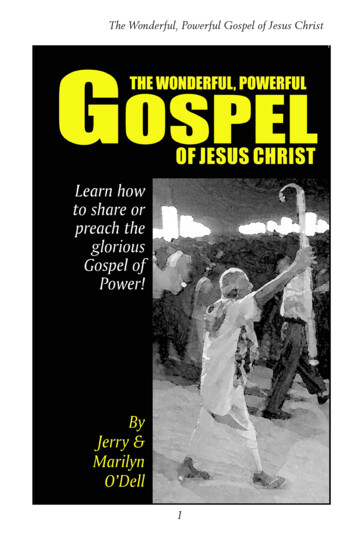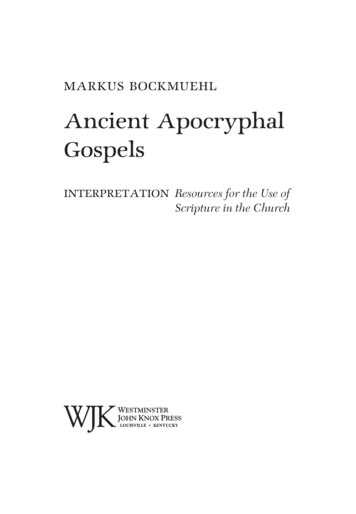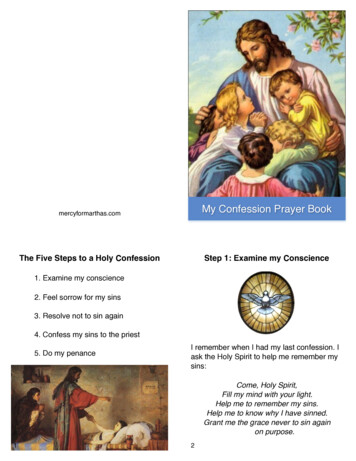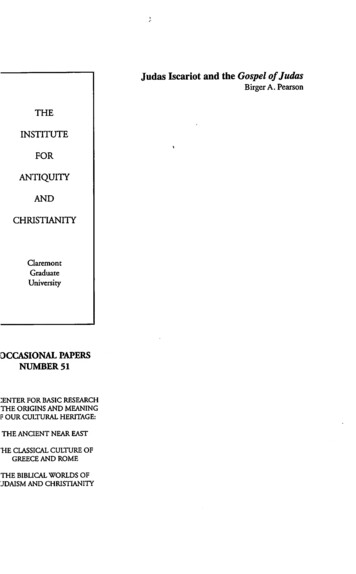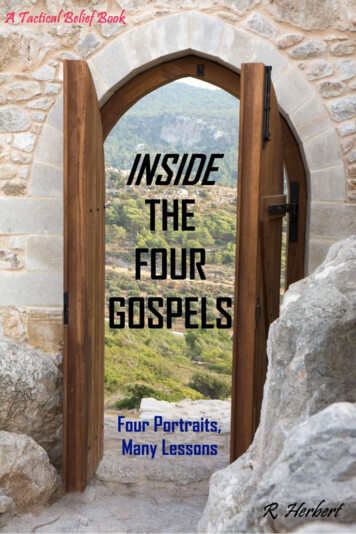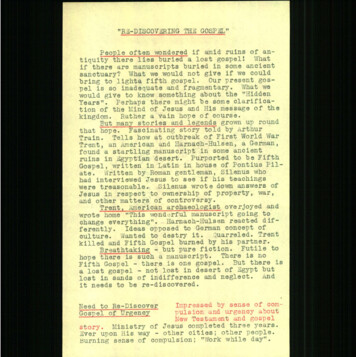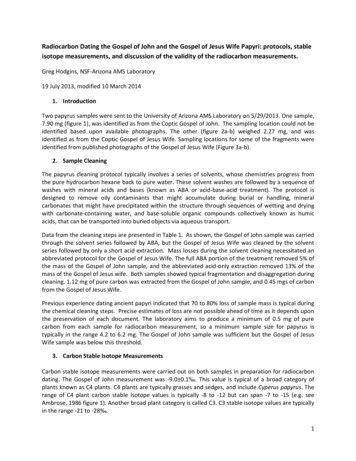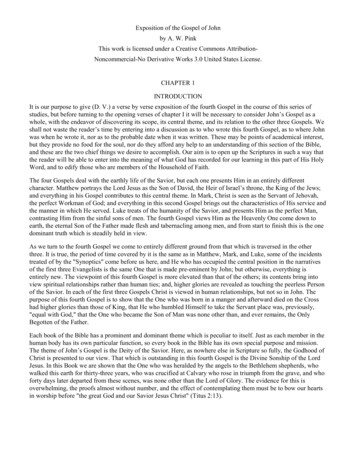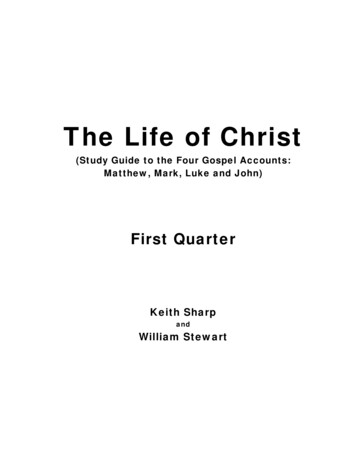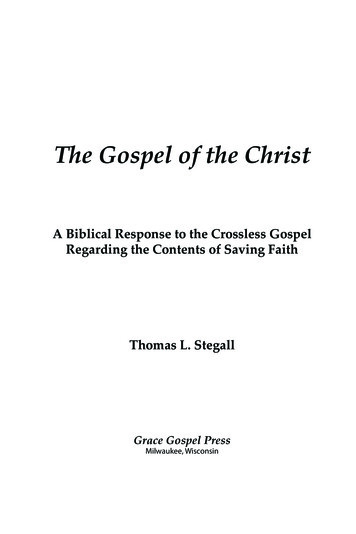
Transcription
The Gospel of the ChristA Biblical Response to the Crossless GospelRegarding the Contents of Saving FaithThomas L. StegallGrace Gospel PressMilwaukee, Wisconsin
The Gospel of the Christ: A Biblical Response to the Crossless Gospel Regarding theContents of Saving Faith 2009 by Thomas L. StegallAll rights reserved. No portion of this publication may be reproduced, storedin a retrieval system, or transmitted in any form or by any means—electronic,mechanical, photocopy, recording, scanning, or other—except for briefquotations, without the prior written permission of the publisher.All Scripture quotations, unless otherwise indicated, are taken from theNew King James Version . Copyright 1982 by Thomas Nelson, Inc.Used by permission. All rights reserved.ISBN 978-0-9799637-4-2 (hardcover)Library of Congress Control Number: 2008910584Cover design by Cynthia HartThe Greek fonts used to publish this work are available fromwww.linguistsoftware.com, 1-425-775-1130.Grace Gospel Press10328 W. Oklahoma Ave.Milwaukee, WI 53227U.S.A.www.gracegospelpress.comPrinted in the United States of America
To Debbie, my truest co-laborer for Christand an heir together with me of the grace of life,without whose support and sacrifice thisbook would not have been written
ACKNOWLEDGMENTSI would like to express my sincere appreciation for the many people thatthe Lord used to contribute to this book in one way or another. The faithful example of two pastors immediately comes to mind, namely my formerpastor and now dear friend, Dennis Rokser, as well as his former pastorand mentor, the late Leonard Radtke. The heritage passed on to me by thesefaithful men of God has profoundly impacted not only my own ministryas a pastor but especially my personal convictions about the foundationalimportance of the gospel and God’s grace for both eternal salvation andthe Christian life. The Lord has used these servant-leaders to teach me to“be strong in the grace that is in Christ Jesus” (2 Tim. 2:1-2). I would also like toexpress my gratitude to others, such as Rick Gerhartz, Randy Zempel, andDr. Robert Lightner who each read portions of the manuscript at variousstages and offered valuable input and encouragement. Darrell Pattersoncreated some of the graphics for the book and offered assistance early onin resolving many word processing problems. Katie Morrison joyfullyserved as a virtual, personal librarian by supplying me with a continuousstream of books and articles. Greg Cooper offered to design the websiteto advertise the book for the new Grace Gospel Press. Christian artistLaura Ibbotson graciously contributed an original painting for the coverof the condensed, reader-friendly version of this book that is forthcoming.Greg Schliesmann fulfilled the monumental task of typesetting the entirebook and assisting in the compilation of the indexes. I am also appreciativeto the entire congregation of saints at the Word of Grace Bible Church, alongwith other like-minded churches, for their faithful prayers and support.I am grateful to the Lord that so many members of His body have beenwilling to stand fast with me “in one spirit, with one mind striving togetherfor the faith of the gospel” (Phil. 1:27).
But God forbid that I should glory, savein the cross of our Lord Jesus Christ, bywhom the world is crucified unto me, and Iunto the world.Galatians 6:14 (KJV)
Down through the ages of history, Christianity has been subjectedto a multitude of influences. There have been creative ideas,new programs, fascinating personalities, fresh approaches totheology, evangelism, missionary activity, and a myriad of otherdiverse developments in the ongoing mission of the church. It isprobably undeniable that, with true spiritual discernment, thesedevelopments should be viewed with guarded favor, and given theopportunity to have their part in the cause of Christ.However, that special and changeless message called “thegospel of the grace of God” must never be subject to creativeideas or diverse developments. The hope of eternal life, the centralmessage of divine revelation, is based upon the finished work ofChrist on Calvary’s cross and the offer of divine mercy which issuestherefrom. The death of the Son of the living God in space and timeand the meaning of that sacrifice is what constitutes this gloriousmessage called the gospel.Should that message ever be changed, then the door to lifeis instantly closed and Christianity becomes a mere humanisticreligion, fascinating perhaps, but valueless. The most valuable andsacred commodity, therefore, on the face of the earth is the truthof the gospel. This is a sacred message worth living for, worthsacrificing for, and worth gladly dying for. It is the only real valueon earth today; it is the truth of all truths to which the church mustbe dedicated to propagate and protect.1– Lance LathamLance B. Latham, The Two Gospels (Streamwood, IL: Awana Clubs International, 1984),xv-xvi.1
CONTENTSAbbreviations11Foreword by Dennis M. Rokser14Preface17PART IEXAMINING THE ERROR OF THE CROSSLESS GOSPEL1.The Tragedy of the Crossless Gospel292.What Other Doctrines Have Changed?493.Why the Crossless Gospel?654.Is John 6:47 Really the Saving Message?815.Is the New Gospel Truly “Crossless”?996.What Is the Significance of the Name of Jesus?129PART IICLARIFYING THE SAVING GOSPEL OF CHRIST7.Has Progressive Revelation Changed the Gospel?1558.Is the Gospel a Broad, Non-Soteriological Message?2139.Is the Gospel of Christ the Saving Message?27110. What Is the Gospel to the Galatians?33511. What Is the Gospel to the Thessalonians & Timothy?38112. What Is the Gospel According to Romans?41113. What Is the Gospel According to 1 Corinthians 15:1-2?47914. What Is the Gospel According to 1 Corinthians 15:3-11?529
PART IIICLARIFYING THE CHRIST OF SAVING FAITH15. What Does “the Christ” Mean in the OT & Synoptic Gospels?59316. What Does “the Christ” Mean in Acts 2?62717. What Does “the Christ” Mean in the Rest of Acts?66318. Is Christ’s Virgin Birth Essential to Believe for Salvation?705CONCLUSION19. Why Does This Matter?747Appendix: Other Free Grace Voices755Bibliography of Works Cited765Author & Person Index797Subject Index805Scripture Index10815
ETREvQExpTAnchor BibleBauer, Walter. A Greek-English Lexicon of the New Testamentand Other Early Christian Literature. Revised and augmentedby F. Wilbur Gingrich and Frederick W. Danker. 2nd ed.Chicago: University of Chicago Press, 1979Bulletin for Biblical ResearchBauer, Walter. A Greek-English Lexicon of the New Testamentand Other Early Christian Literature. Revised and edited byFrederick Danker. 3rd ed. Chicago: University of ChicagoPress, 2000Brown, F., S. Driver, and C. Briggs. The Brown-Driver-BriggsHebrew and English Lexicon. Peabody, MA: HendricksonPublishers, 1996Blass, Friedrich, and Albert Debrunner. A Greek Grammarof the New Testament and Other Early Christian Literature.Translated by Robert W. Funk. Chicago: University of ChicagoPress, 1961Baker Exegetical Commentary on the New TestamentBibliotheca Ephemeridum Theologicarum LovaniensiumBiblia Hebraica StuttgartensiaBiblicaBulletin of the John Rylands LibraryBible Knowledge CommentaryBlack’s New Testament CommentaryBible ReviewBibliotheca SacraCatholic Biblical QuarterlyCambridge Greek Testament CommentaryCritical TextConservative Theological JournalConcordia Theological MonthlyConcordia Theological QuarterlyCriswell Theological ReviewChafer Theological Seminary JournalDetroit Baptist Seminary JournalEveryman’s Bible CommentaryExegetical Dictionary of the New Testament. Edited byHorst Balz and Gerhard Schneider. 3 vols. Grand Rapids:Eerdmans, 1990-93Evangelical Theological ReviewEvangelical QuarterlyExpository Times11
CNTNICOTNIDNTTNIDOTTFilologia NeotestamentariaGrace Family JournalGreek New Testament according to the Majority Text. Edited byZane C. Hodges and Arthur L. Farstad. Nashville: ThomasNelson, 1982Grace Theological JournalInternational Critical CommentaryInterpreter’s Dictionary of the Bible. Edited by George A.Buttrick. 4 vols. Nashville: Abingdon Press, 1962InterpretationInternational Standard Bible Encyclopedia. Revised Edition.Edited by Geoffrey W. Bromiley. 4 vols. Grand Rapids:Eerdmans, 1980-88Irish Theological QuarterlyJournal of Biblical LiteratureJournal of the Evangelical Theological SocietyJournal of the Grace Evangelical SocietyJournal for the Study of the New TestamentJournal of Theological StudiesKing James VersionLouw, Johannes P., and Eugene A. Nida. Greek-EnglishLexicon of the New Testament: Based on Semantic Domains. 2vols. New York: United Bible Societies, 1988Liddell, Henry George, and Robert Scott, comps. A GreekEnglish Lexicon. Revised and augmented by Henry StuartJones and Roderick McKenzie. 9th ed. With a RevisedSupplement 1996. Edited by P. G. W. Glare and A. A.Thompson. Oxford: Clarendon Press, 1940Septuaginta. Edited by Alfred Rahlfs. Stuttgart: DeutscheBibelgesellschaft, 1979Moody Gospel CommentaryMaster’s Seminary JournalMajority TextNovum Testamentum Graece. Edited by Barbara and KurtAland, Johannes Karavidopoulos, Carlo M. Martini, andBruce M. Metzger, 27th Revised Edition. Stuttgart: DeutscheBibelgesellschaft, 1993New American Standard BibleNeotestamenticaNew International Biblical CommentaryNew International Commentary on the New TestamentNew International Commentary on the Old TestamentNew International Dictionary of New Testament Theology.Edited by Colin Brown. 4 vols. Grand Rapids: ZondervanPublishing House, 1975-78New International Dictionary of Old Testament Theology and12
BCWTJZNWExegesis. Edited by Willem A. VanGemeren. 5 vols. GrandRapids: Zondervan Publishing House, 1997New International Greek Testament CommentaryNew International VersionNew King James VersionNovum TestamentumNew TestamentThe New Testament in the Original Greek: Byzantine Textform.Compiled and Arranged by Maurice A. Robinson & WilliamG. Pierpont. Southborough, MA: Chilton Publishing, 2005New Testament StudiesOld TestamentPillar New Testament CommentaryReview & ExpositorReformed Theological ReviewSemeiaScottish Journal of TheologyStudia TheologicaTyndale BulletinTheological Dictionary of the New Testament. Edited byGerhard Kittel and Gerhard Friedrich. Translated byGeoffrey W. Bromiley. Index compiled by Ronald E. Pitkin.10 vols. Grand Rapids: Zondervan Publishing House,1964-76ThemeliosThesaurus Linguae GraecaeTyndale New Testament CommentaryTextus ReceptusTrinity JournalTheological Wordbook of the Old Testament. Edited by R. LairdHarris, Gleason L. Archer, Jr., and Bruce K. Waltke. 2 vols.Chicago: Moody Press, 1980The Greek New Testament. Edited by Barbara Aland, KurtAland, Johannes Karvidopoulos, Carlo M. Martini, andBruce M. Metzger. 4th rev. ed. Stuttgart: United BibleSocieties, 1993Vigiliae ChristianaeVox EvangelicaVetus TestamentumWord Biblical CommentaryWestminster Theological JournalZeitschrift für die neutestamentliche Wissenschaft13
FOREWORDWhen I was 18 years old, I understood for the first time (through the witnessof some friends) God’s wonderful plan of salvation by grace. Though I wasraised in a religious, God-fearing home, I was under the satanic deception(through my religion) that eternal salvation was a reward for good peopleand good works, instead of being a free gift for sinners paid for completelythrough the sacrifice of Christ and offered to me by God’s love (Rom. 5:8;Eph. 2:8-9). While I believed the Bible to be the Word of God, I really hadno clue what was written in it as I followed the traditions of men insteadof the truth of God (Matt. 15:6-8). And though I believed several importantfacts about Jesus Christ and knew the stories of Christmas and Easter, myfaith was in Christ PLUS, not in Christ alone PERIOD (John 3:16).What made the difference in my thinking and opened my eyes to thetruth of the Gospel of grace? It was the words of the Lord Jesus Christupon the cross when He triumphantly declared, IT IS FINISHED! (John19:30). For though I had believed that Christ’s death was NECESSARYto go to Heaven, I finally understood that Christ’s finished work wasENOUGH to be saved forever. He alone had died for all my sins past, present, and future and rose from the dead to give me eternal life freely andforever. My sins had been PAID IN FULL by Jesus Christ at Calvary andthere was nothing left for me to do but to simply put my faith alone inthe crucified and risen Savior, the Lord Jesus Christ (Acts 16:31). ThenI finally possessed a KNOW-SO salvation instead of a HOPE-SO one (1John 5:9-13). Finally I had a personal relationship with God by His gracethrough divine accomplishment instead of a religious system of meritorious performance through human achievement (Rom. 4:4-5). Now I couldunderstand and fully agree with the words of the apostle Paul when hewrote, “For the message of the cross is foolishness to those who are perishing,but to us who are being saved it is the power of God. . . . For since, in the wisdomof God, the world through wisdom did not know God, it pleased God through thefoolishness of the message preached to save those who believe” (1 Cor. 1:18, 21). Itwas an understanding of the work of the cross of Christ, not the elimination or downplaying of this that made the difference for me, like so manyothers.Since the early days of my Christian life, I read in the Scriptures andheard preached from the pulpit both the crucial necessity of proclaiming accurately the message of the Gospel (Rom. 1:16) but also the criticalimportance of guarding its purity (1 Tim. 6:20-21) and contending for itscontents (Jude 3). The words of Galatians 1:8-9 were burned like a hotiron into my conscience, “But even if we, or an angel from heaven, preach anyother gospel to you than what we have preached to you, let him be accursed. Aswe have said before, so now I say again, if anyone preaches any other gospel to14
Forewordyou than what you have received, let him be accursed.” The Gospel must neverbe garbled or gutted but fearlessly guarded. Thus, even in a prison cellfor preaching the Gospel, Paul penned that he was “set for the defense ofthe Gospel” (Phil. 1:17). What a contrast and source of conviction in ourpostmodern times that rejects moral absolute truth, and where even theevangelical church compromises the truth of the Gospel as it pragmatically practices the ends-justifies-the-means for the sake of attractingbodies into a building under the guise of church growth. May God bemerciful to us.Thus, the Gospel of grace is sacred ground. It is non-negotiable truth.It is the bottom-line that distinguishes Christianity from all the religions of the world. Remove the Gospel of grace from Christianity, and itbecomes merely a system of meritorious salvation and ethical behaviorwithout the power of God. So should it surprise us that Satan’s attacksagainst the Gospel are endless like the waves of the sea beating upon theshore? Yet, what is so unfortunate about the necessity of this book is thatthe recent attack upon the Gospel is not from foes of the Free Grace movement but from its friends—those who have stood shoulder to shoulder inwithstanding the false gospel of Lordship Salvation.Dear reader, it is helpful to remember that controversy is not new tothe Church. It’s like what one old sage wrote, “The church is a lot likeNoah’s ark. If it wasn’t for the judgment on the outside, you could neverstand the smell on the inside.” And though Satan seeks to use controversyto divide and conquer, God seeks to use it to refine our understanding ofthe Scriptures and to purify His Church. Thus, while I do not relish thecontroversy of the crossless gospel, it was foisted upon us and requires abiblical response and defense of the Gospel. Tom has done this admirablyin this book by God’s grace through “speaking the truth in love.”Therefore, I am grateful for this scripturally-sound, exegeticallybased volume by my dear friend, Thomas Stegall. While this book is notlight weight for the casual late-night reader, it is loaded with scripturalinsights that emerge from the biblical text by recognizing its context,observing its content, and then comparing Scripture with Scripture inorder to arrive at a biblical and balanced conclusion. In doing so, Tom hasnot been afraid to tackle a number of difficult passages and unscripturaldefenses in targeting the faulty conclusions of the crossless adherents,while surfacing the correct interpretation of the Scriptures.Frankly, I know of nothing in writing from the Free Grace perspectivethat interacts and intersects biblically like this book does regarding all ofthe following issues in one volume, such as . . . the false teaching of the crossless gospelthe nature and content of saving faiththe comparison of the evangelistic message of John as it relates tothe Synoptic Gospels, Acts, and the Epistles15
THE GOSPEL OF THE CHRIST the name of Jesus Christ referring to His person and workthe reality of progressive revelation as it relates to the Gospelthe distinction between the various forms of good newsthe problem passages in the Book of Actsthe necessity of repentance for salvationthe supposed wrath of God upon disobedient believers in Christthe issue of judicial forgiveness versus fellowship forgivenessthe distinguishing of eternal and temporal salvationthe relationship of various doctrines like the Virgin Birth to ourredemption and the contents of the GospelMay God be pleased to use His Word as set forth in this book to expoundthe truth of the Gospel and expose the error of the crossless gospel so “thatthe truth of the gospel might continue with you” (Gal. 2:5).Dennis M. RokserDecember 26, 200816
PREFACEThe book you are reading concerns a question of the greatest eternal consequence: “What does God require a person to believe in order to receiveeternal life?” While many books in the already flooded field of Christianliterature deal with theology, and many even with the doctrine of salvationknown as soteriology, this book focuses primarily on the question of thecontents of saving faith. What must a person believe about Jesus Christ inorder to go to heaven?The answer to that question is so simple that even a child can knowthe truth about Christ, believe in Him, and be saved. It is so simple thatit can be answered in a single sentence. So I will offer my answer to thatquestion, and the thesis of this book, right up front. A person must simply believe the gospel of Christ, which is the message that, as “the Christ,the Son of God,” Jesus is both God and man, and the One who died for allour sins and rose from the dead in order to provide salvation by gracethrough faith in Him (John 3:13-18; 5:24; 6:32-53; 8:24, 28; 20:30-31; Acts16:30-31; 1 Cor. 1:17-21; 15:1-4; Eph. 2:8-9; 2 Thess. 1:6-10). While there arevarious ways to express the same truth, that’s it, plain and simple. Whenpeople believe this, they receive eternal life.But obviously this book is not written for children. Nor do children,or even adults, need to understand all the exegetical and theological complexities covered herein to be saved. The depth and scope of this book isnecessary due to the doctrinal controversy in our day created by somewell-meaning evangelical theologians who believe that the single-sentence answer provided above is unbiblical. They believe it is too complex,that the contents of saving faith must be simpler yet. They would deconstruct each portion of my answer, whittling it down phrase by phrase,word by word, denying that the lost even need to believe the gospel, oracknowledge that man is a sinner, or that Jesus Christ is God the Son, orthat He died for man’s sins and rose from the dead. In support of such analarming conclusion, they have created whole new paradigms throughwhich they are interpreting the Scriptures and in the process causingconfusion and spiritual stumbling within the Body of Christ, especiallyin Free Grace circles.It is my sincere prayer and heart’s desire that God will use this bookto not merely answer the errors of the crossless gospel, but more importantly, to provide a positive, constructive articulation of biblical truth Thomas L. Constable, “The Gospel Message,” in Walvoord: A Tribute, ed. Donald K.Campbell (Chicago: Moody Press, 1982), 204; J. B. Hixson, Getting the Gospel Wrong: TheEvangelical Crisis No One Is Talking About (n.p.: Xulon Press, 2008), 122; J. Gresham Machen,Christianity and Liberalism (Grand Rapids: Eerdmans, 1923), 118.17
THE GOSPEL OF THE CHRISTregarding the contents of saving faith. If this has been achieved by God’sgrace, then may He be pleased to use this book to bring clarity, resolution,and healing to the Body of Christ in the wake of the “crossless gospel.”I have also chosen to keep the phrase “crossless gospel” in the subtitleand employ it consistently throughout this book, despite the misgivingsof some Free Grace people. If you find this expression particularly objectionable, please be sure to read chapter 5 where I provide the rationale forwhy this phrase is fitting, though admittedly unpleasant.Threefold Basis for the Contents of Saving FaithAs a reader, it will also be helpful for you to understand at the outset whatthe thesis of this book is based upon. The contents of saving faith articulated in this book have not been chosen arbitrarily. In the last few years,as I prayerfully and carefully studied each passage containing the variousforms of the word “gospel,” as well as studying the Johannine writingsand many other individual, soteriologically significant passages, the consistency and coherence of God’s Word became evident and overwhelming.The Lord has not been vague about what He requires us to believe in orderto be born again. Nor has He hidden it from us. This is not a matter of thesecret things belonging only to the Lord in contrast to the truths He hasrevealed (Deut. 29:29). He has provided abundant revelatory testimonyto mankind in order to answer the question of what we must believe. Hehas provided a cord of at least three strands in testifying to the contentsof saving faith.First, the gospel itself is found to be equivalent with the contents ofsaving faith. While that may seem obvious to most evangelical Christians,it has enormous implications for the current crossless controversy. Interms of actual content, the gospel is not the broad, nebulous conceptthat crossless proponents have recently purported it to be. Rather, thegospel is specifically about the person and work of God’s Son, as well asthe provision of salvation and the sole condition of faith in Him. Thoughthe term “gospel” most often stands alone in the New Testament withoutany other qualifying words or phrases, when it is modified, the most frequent modifier attached to it is the phrase “of Christ,” as in “the gospelof Christ.” However, the underlying Greek text is even more specific. Itemploys the article before “Christ” so that the phrase in Greek is literally,“the gospel of the Christ” (Rom. 1:16; 15:19, 29; 1 Cor. 9:12, 18; 2 Cor. 9:13;10:14; Gal. 1:7; Phil. 1:27; 1 Thess. 3:2). This means that the gospel that lostsinners must believe for their deliverance from eternal condemnation isa particular message about a particular person. It is the particular message about Jesus being “the Christ.” But this naturally raises the question,“What does it mean to be the Christ?”Secondly, God has revealed the content of saving faith in Scripturethrough the meaning He has invested in the key titles, “the Christ,” “theSon of God,” and “the Son of Man.” It becomes clear that, in the evangelis-18
Prefacetic contexts of the Synoptic Gospels and the Book of Acts, these titles andterms convey the Lord’s substitutionary death and bodily resurrection inaddition to His deity and humanity. This is especially evident in the writings of the apostle John. Thus, to believe in Jesus as “the Christ, the Son ofGod” (John 20:31) is equivalent to believing “the gospel of the Christ.”Thirdly, the Word of God testifies that not every doctrine about Christis part of the gospel or essential to believe for everlasting life. In the various individual passages of Scripture that require belief in some aspect ofChrist’s person or work, it is conspicuous that the doctrines about Christthat are essential to know and believe for eternal life happen to coincidewith the very grounds of mankind’s redemption. This again testifies tothe Lord’s deity, humanity, substitutionary death, and bodily resurrection, i.e., to His person, work, and provision.All three of these lines of evidence function as virtual mirror reflections of one another in an amazing triangular testimony to the contentsof saving faith. In some passages, the Lord requires the lost to believe thegospel in order to receive eternal salvation. In other passages, He conditions eternal life upon believing that Jesus is the Christ, the Son of Godand Son of Man. These “gospel” versus “Christ”/“Son” passages do notrepresent two separate, disparate contents of saving faith; rather, theyare alternate expressions for the same required content. The congruenceof this testimony to the contents of saving faith cannot be a coincidencebut is evidence of the divine design intended by the Spirit of God whenHe supernaturally inspired His Word. This means that the requirementto believe in Jesus’ deity, humanity, substitutionary death, and bodilyresurrection is not the result of imposing our own arbitrary, manmadeevangelical orthodoxy upon the Scriptures. It is quite the opposite. Godhas placed this pattern in Scripture and it has been there all along for usto behold and believe. For this reason, the historic evangelical position If God graciously wills and permits, it is my intent to finish a separate volume alreadyunderway devoted entirely to the contents of saving faith from a Johannine perspective.19
THE GOSPEL OF THE CHRISTthat belief in Christ’s person and work is a divine requirement for salvation is affirmed by the resounding, diverse, and yet consistent testimonyof God’s Word rather than by human tradition or personal opinion.Audience, Approach, and AssumptionsThough the content of saving faith is so simple that even a child can possessa rudimentary grasp of Christ’s person and work and be saved, it is stilla vast and sweeping subject in the Word of God. At times, this book will“zoom-in” to minutely exegete individual verses, while routinely “zooming-out” to recapture the bigger picture that these passages are painting.The use of technical language at points has been unavoidable in seekingto accurately interpret Scripture and to convey its truths with precision. Attimes, the riches of God’s Word are lying right on the surface, waiting tobe gathered up and put in our basket. At other times, they are found onlythrough deep mining. In this respect, I have written for a target audiencethat will encompass not only fellow pastors and teachers, as well as highlytrained theologians, but also any believer who is serious about studyingGod’s Word with the heart and diligence of a Berean (Acts 17:11). With thisdiverse audience in mind, I have given the transliteration of Hebrew andGreek words as often as possible, except when providing an exact quotation from another source.As a reader, you should also know up front what theological presuppositions I bring to this book on the contents of saving faith. I havewritten from a firm belief in the verbal, plenary inspiration and inerrancyof Scripture. In addition, I affirm without apology a normative premillennial, dispensational position. I am convinced that only a dispensationalapproach to Scripture yields a harmonious, non-contradictory doctrineof progressive revelation regarding the contents of saving faith. In addition, only a dispensational approach to Scripture allows the interpreter toproperly distinguish the different forms of “good news” or gospels thatexist in Scripture. If Augustine allegedly said, “Distinguish the ages andthe Scriptures harmonize,” we may also add, “Distinguish the ages andthe gospels harmonize.”Though I have sought to accurately interpret God’s Word to the bestof my ability, and I am confident that my overall conclusions are correct, Iam also conscious of my own fallibility. I am certain that others will findneeded corrections and improvements to what I have written, and that isgood. I know nothing yet as I ought to know it (1 Cor. 8:2; Gal. 6:3). But Itrust that what I have written will generate Spirit-led discussion amongGod’s people and a sincere searching of His Word with the intent to “buythe truth and sell it not” (Prov. 23:23). Lewis Sperry Chafer, Dispensationalism, Revised Edition (Dallas: Dallas Seminary Press,1951), 11; The Scofield Study Bible, King James Version, ed. C. I. Scofield (Oxford: Oxford University Press, 1917), iii.20
PrefaceMotives in WritingIt is also fair that you know up front what my motives are in writing. Iwish to say first of all that I have no animosity or hard feelings towardsthose leaders and teachers within the Free Grace movement who hold to acrossless gospel and who are referenced profusely throughout this book.Though I stand against their doctrine, I stand for them spiritually as fellow brothers in Christ, and I desire and pray for their repentance. In fact,I genuinely appreciate many of their valuable contributions made in FreeGrace theology in the past, aside from their more recent doctrinal departures that are documented here.But as a member of the Grace Evangelical Society for over 15 years,I became increasingly uneasy with both the number and magnitude ofthe doctrinal deviations taking place. Yet I remained largely a spectator,uninvolved
importance of the gospel and God’s grace for both eternal salvation and the Christian life. The Lord has used these servant-leaders to teach me to “be strong in the grace that is in Christ Jesus” (2 Tim. 2:1-2). I would also like to express my grat
